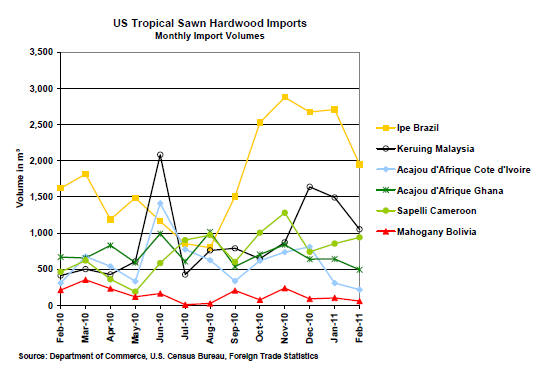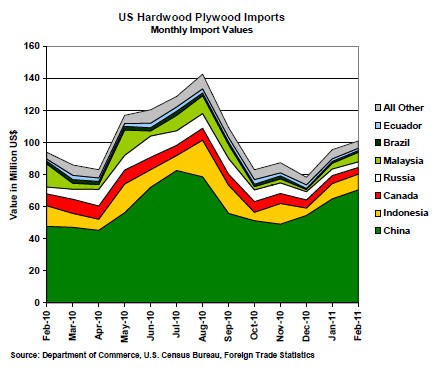|
Report
from
North America
February US housing market figures disappoint
New housing starts decreased by 22.5% from January to
February to 479,000 (seasonally adjusted) according to US
Department of Commerce figures.
This is 20.5% below the starts in February last year. In
January, housing starts had gone up because multi-family
starts soared, but this sector also posted a decline in
February. Single-family starts continued the downward
trend and decreased by 11.8% from January to February,
while analysts had expected a slight increase in the new
year. Every region of the country posted a decline in starts
in February.
Permits for new homes fell in January and February, but
this less of a surprise because there was a scheduled
change in building codes and builders applied for more
permits than usual in December before the code changes
took effect in January. The number of permits issued can
be an indicator of future building activity.
The National Association of Home Builders attributes the
poor numbers to tight credit for housing and uncertainty
around interest rates, energy costs and the economy.
Home renovation spending expected to grow in 2011
Home remodeling expenditure in the US is expected to
recover in 2011. The Joint Center for Housing Studies at
Harvard University projects an annual growth of 6.5% in
home improvement spending in the third quarter of 2011.
Home sales (and as a result remodeling expenditure) is
expected to pick up in the summer this year.
However, the large number of foreclosed homes on the
market and the resulting low house prices will put a
damper on home renovations and spending is projected to
decline again in the third quarter of 2011.
Launch of “Green Marketing Pledge”
A group of US green product manufacturers, distributors,
retailers and purchasers have launched a public campaign
to put an end to the use of misleading green product claims
in the marketplace. The Green Products Roundtable
includes the Business and Institutional Furniture
Manufacturers’ Association and the forest products
company Weyerhaeuser.
The Roundtable members commit to responsible green
marketing and to adherence to environmental marketing
guidelines established by the Federal Trade Commission.
The Green Products Roundtable is funded by membership
fees, foundations and the US government.
Signs that the US market continues to recover
The latest US import statistics which are for February
2011 show that imports are up compared to the previous
year, a sign that the market continues to recover, although
import volumes and values remain much lower than before
the recession started in 2008.
The US imported 14,991 cu.m. of sawn tropical hardwood
in February 2011, which represents a drop of 19% from
18,448 cu.m. in January. All major imported species
showed declines with the exception of sapele for which
imports increased to 2,060 cu.m. (+24%).
Balsa imports dropped by 26% to 3,970 cu.m. in February.
Ipe imports were 2,127 cu.m. (-28%), acajou d’Afrique
1,339 cu.m. (-18%) and keruing 1,246 cu.m. (-25%).
While imports of most species declined from January,
import volumes increased for virola (1,129 cu.m. (+92%)
and cedro (1,141 cu.m., +131%).
Cameroon was the only major supplier that increased sawn
tropical hardwood shipments in February, mostly in acajou
d’Afrique sawnwood while Cote d’Ivoire shipments of
acajou declined. Monthly import volumes of key imported
species by country of origin are shown below.

Year-to-date, import volumes of tropical sawnwood
increased by 19% compared with February 2010. Among
the species that gained significantly year-to-date February
2011 are ipe (+68%), sapelle (+201%) and keruing
(+141%).
Hardwood plywood imports from China rebound
US imports of hardwood plywood increased to US$101
million in February 2011, up 6% from January. Year-todate
the gain was 12%. Imports from China rebounded:
70% of total February imports were from China and yearto-
date imports from China were up 41% compared to
2010.
Imports from other major supplying countries fell,
especially Malaysia which saw a year-to-date decline of -
47% compared to the previous year. February imports
from Indonesia were US$9.9 million (-19% year-to-date),
from Malaysia US$5.9 million (-47% year-to-date), from
Ecuador US$1.5 million (+8% year-to-date), and from
Brazil US$1.1 million (-29% year-to-date).

Brazil and China dominate hardwood moulding
imports
Imports of hardwood moulding were worth US$15.8
million in February 2011, a decrease of -7% from January.
Year-to-date imports were still higher than in 2010, with
strong gains from all tropical suppliers.
Imports from Brazil were US$5.1 million (+27% year-todate),
from Malaysia US$1.3 million (+45% year-to-date),
from Indonesia US$452,000 (+32% year-to-date). Imports
from China were US$4.8 million (+16% year-to-date).
February imports of jatoba mouldings from Brazil were
US$2.4 million (+46% year-to-date), of ipe moulding
US$387,000 (-8% year-to-date), and of cumaru moulding
US$175,000 (-35% year-to-date). Supplies of cumaru
mouldings from Peru were US$399,000 in February
(+90% year-to-date).
Mahogany moulding imports from Peru were US$170,000
in December (-12% year-to-date) and from Paraguay
US$168,000 (+74% year-to-date).
Year-to-date imports of all tropical hardwood moulding
species increased in February. Jatoba accounts for the vast
majority of tropical hardwood moulding imports. The
value of jatoba imports year-to-date February increased by
+54% compared to 2010.
Year-to-date imports of cumaru moulding were up +19%,
ipe moulding +23% and mahogany moulding +10%.
Hardwood flooring imports more than doubled from
2010
Hardwood flooring imports were US$1.6 million in
February, a -29% decline from January, but total 2011
imports to date more than doubled from 2010.
Hardwood flooring imports from China were US$509,000,
from Brazil US$314,000 and from Malaysia US$280,000.
On a year-to-date basis, imports from Brazil increased by
+106% from 2009, Malaysian exports increased by
+150%, Indonesian exports increased by +144%. Chinese
exports to the US recovered from the decline last fall and
were up by +123% year-to-date compared to 2009.

Related News:
|